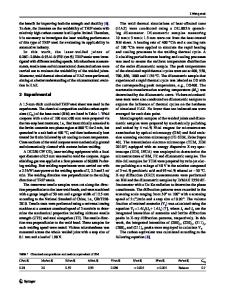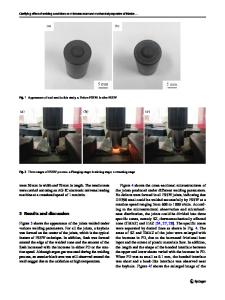Effect of Welding Parameters on Microstructure, Thermal, and Mechanical Properties of Friction-Stir Welded Joints of AA7
- PDF / 3,571,889 Bytes
- 16 Pages / 593.972 x 792 pts Page_size
- 15 Downloads / 498 Views
UCTION
FRICTION-stir welding (FSW), which was invented by the welding institute of the United Kingdom in 1991, is a solid-state joining process in which a nonconsumable rotating pin is inserted into the butting edges of the sheets to be welded with an especially designed tool and tilt angle.[1] A high joining speed, autogenous welding, enhanced mechanical and metallurgical properties, and moderated need for human skill are among the most important advantages of FSW in comparison to conventional fusion welding methods.[2] Such a joining process avoids severe distortions and is being targeted by the modern aerospace industry for structurally demanding applications providing high performance benefits.[3–5] During friction-stir welding, the heat generation caused by the friction between the welding tool and weld metal makes the surrounding material around the tool soft, and it results in a recirculating flow of plasticized material nearby the tool surface.[6,7] The FSW process has appeared as one of the most significant achievements for joining aluminum alloys and has been successfully implemented into commercial AMIR HOSSEIN LOTFI, MSc Student, and SALMAN NOUROUZI, Associate Professor, are with the Department of Mechanical Engineering, Babol Noshirvani University of Technology, Babol 47148-71167, Mazandaran, Iran. Contact e-mail: [email protected] Manuscript submitted June 27, 2013. Article published online March 28, 2014 2792—VOLUME 45A, JUNE 2014
applications.[8] High-strength aluminum alloys (2xxx and 7xxx series) are normally difficult to be welded with traditional welding techniques due to dendritic structure formation in the fusion zone that leads to extreme reduction of the mechanical behavior. In addition, the wide melting range and low solidus temperature make high-strength aluminum alloys excessively sensitive to hot cracking unless a compressive load is applied. However, FSW is capable of fabricating high-integrity joints of high strength aluminum alloys when optimized parameters are used.[9,10] The zinc-containing aluminum alloy AA7075-T6 is one of the strongest aluminum alloys that possesses an excellent combination of mechanical properties such as a high strength-to-weight ratio, toughness, and fatigue strength properties. Also, its natural aging characteristics make it appealing for common use in the automobile and aerospace applications. A main problem with this alloy is that it is not fusion weldable because of its extreme sensitivity to weld solidification cracking as well as heat-affected zone liquation cracking due to the presence of copper and developing numerous problems such as porosity, lack of fusion, and hazardous fumes due to zinc oxidation or vaporization during welding.[11–13] Considering the aforementioned problems, using solid-state processes like friction-stir welding is suitable for aluminum alloy AA7075. While friction-stir welding of aluminum alloys has been widely reported, information on the influence of high-profile parameters on AA7075 friction-stir welding joints by the use of design
Data Loading...











